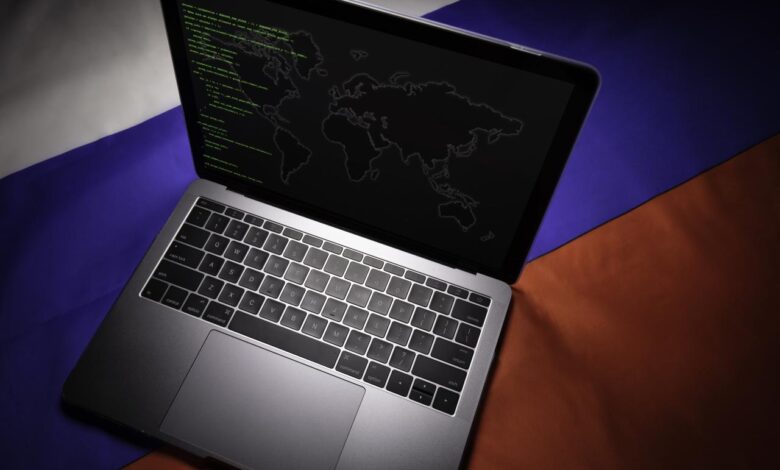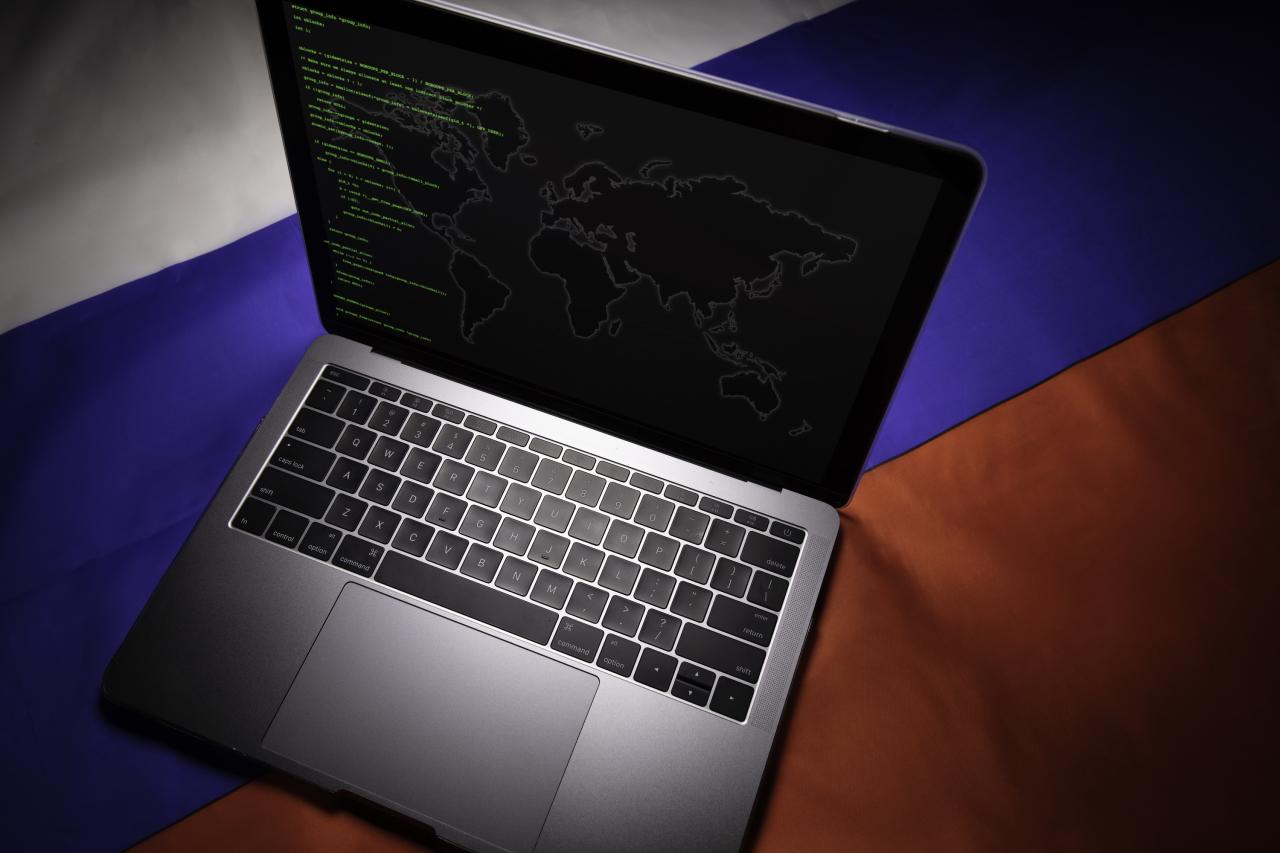
Anonymous Used Conti Ransomware to Down Russian Satellites
Anonymous Used Conti Ransomware to Down Russian Satellites – Whoa! That headline alone is enough to make your head spin, right? This isn’t your average Friday afternoon hacking incident; we’re talking about a potential game-changer in the ongoing geopolitical landscape. Allegations swirl that the infamous Anonymous collective leveraged the powerful Conti ransomware to cripple Russian satellite infrastructure.
This post dives deep into the claims, exploring the evidence, the potential impact, and the wider implications of such a daring cyberattack.
The story is complex, filled with whispers of state-sponsored actors, shadowy cybercrime groups, and the ever-evolving world of digital warfare. We’ll examine Conti’s history, its ruthless tactics, and how its ransomware might have been weaponized in this alleged attack. We’ll also look at the potential consequences – from disrupted communications and navigation to the broader geopolitical fallout. Get ready for a wild ride through the murky world of cyber espionage and high-stakes digital conflict!
The Conti Ransomware Group and its Activities
Conti, a prolific and highly sophisticated ransomware-as-a-service (RaaS) operation, emerged as a major threat in the cybercriminal landscape. Its activities, characterized by aggressive targeting of large organizations and a complex operational structure, have caused significant financial and reputational damage globally. Understanding Conti’s history, tactics, and impact is crucial for mitigating future ransomware attacks.
The Conti ransomware group’s origins are somewhat shrouded in mystery, but its rise to prominence began around 2020. It quickly established itself as a leading RaaS operation, attracting affiliates who carried out attacks in exchange for a share of the ransom payments. Conti’s success was fueled by its robust infrastructure, advanced encryption techniques, and a sophisticated double extortion model, which involved both encrypting data and threatening to leak stolen information if the ransom wasn’t paid.
Over time, the group refined its tactics, incorporating techniques like initial access brokers (IABs) and leveraging vulnerabilities to gain entry into victim networks.
Conti’s Targets and Attack Methods
Conti primarily targeted large organizations across various sectors, including healthcare, manufacturing, finance, and government. Their attacks often involved spear-phishing campaigns, exploiting vulnerabilities in software, or using compromised credentials obtained through IABs. Once inside a network, Conti actors would move laterally, gaining access to sensitive data before deploying the ransomware to encrypt critical systems. This double extortion strategy, combining data encryption with the threat of data leaks, significantly increased the pressure on victims to pay ransoms.
Examples of Conti Ransomware Attacks and Their Impact
The impact of Conti’s attacks was widespread and severe. One notable example involved the attack on a major Irish healthcare provider in 2021, which resulted in widespread disruption of services and significant financial losses. Another significant attack targeted a large U.S. manufacturing company, leading to operational downtime and the theft of sensitive intellectual property. These attacks highlight Conti’s ability to cripple essential services and cause substantial economic damage.
The sheer scale of their operations, combined with the sensitive nature of the data they targeted, underscores the gravity of the threat they posed.
Comparison of Conti’s Tactics to Other Prominent Ransomware Groups
While sharing similarities with other prominent ransomware groups like REvil and DarkSide in their use of RaaS models and double extortion, Conti distinguished itself through its operational sophistication and aggressive targeting of large enterprises. Compared to some groups that focused on smaller, less resilient targets, Conti demonstrated a higher level of technical expertise and a greater capacity for large-scale attacks.
This focus on high-value targets translated into significantly larger ransom demands and greater potential for financial gain.
Timeline of Significant Conti Operations and Alleged Connections to Russian Intelligence
A detailed timeline of Conti’s operations is difficult to definitively compile due to the secretive nature of the group and the ongoing investigations. However, several key events and alleged connections are worth noting. Reports have linked Conti to Russian intelligence services, although the extent of this involvement remains unclear and subject to ongoing debate. The timing of some attacks, and the geographical locations of targeted victims, have fueled speculation about potential state-sponsored activities or at least tacit approval from Russian authorities.
The eventual dismantling of the Conti infrastructure, following international pressure and law enforcement actions, represents a significant blow to the group, but the threat from similar ransomware operations persists.
Attribution and the Claim of Anonymous Involvement
The claim that Anonymous was responsible for disrupting Russian satellites using Conti ransomware is a complex one, shrouded in the inherent difficulties of attributing cyberattacks. While Anonymous claimed responsibility, concrete evidence remains scarce, leaving room for both speculation and skepticism. The lack of definitive proof highlights the challenges in verifying such claims in the often opaque world of cyber warfare.The alleged involvement of Anonymous hinges primarily on the group’s public pronouncements.
Various Anonymous-affiliated accounts on social media platforms claimed credit for the attack, often accompanied by statements aligning with the group’s general anti-Russian stance. However, these statements lack the technical details and verifiable proof typically associated with credible claims of responsibility in sophisticated cyberattacks. The absence of leaked data, specific technical details about the exploit, or forensic evidence linking the attack to known Anonymous infrastructure weakens the claim considerably.
Evidence Supporting and Refuting Anonymous’s Claim
Claims of Anonymous involvement lack substantial supporting evidence. While social media posts claiming responsibility exist, these are easily fabricated and lack the forensic traceability needed for definitive attribution. Furthermore, independent security researchers have not yet produced any conclusive evidence directly linking Anonymous to the satellite disruption. Conversely, the lack of evidence does not definitively disprove Anonymous’s involvement.
The decentralized and anonymous nature of Anonymous makes tracing their actions exceptionally difficult. Attribution in such cases often relies on circumstantial evidence, which, in this instance, is insufficient.
A Hypothetical Scenario of Anonymous’s Use of Conti Ransomware
A plausible, though unverified, scenario involves Anonymous obtaining access to the Conti ransomware source code – leaked following the group’s internal discord leak – or a variant thereof. They could have then modified the malware to target specific vulnerabilities within the satellite control systems. This modified ransomware might have been deployed through a phishing campaign, exploiting a known zero-day vulnerability, or leveraging a compromised third-party system with access to the satellites.
The success of such an operation would hinge on significant technical expertise and detailed knowledge of the satellite’s infrastructure, a level of sophistication that remains questionable given the lack of concrete evidence.
Motivations Behind a Hypothetical Anonymous Attack
If Anonymous were indeed responsible, their motivations would likely align with their broader anti-Russian stance. Disrupting Russian satellite communications could be viewed as a form of cyber warfare, aiming to hinder Russia’s military capabilities or intelligence gathering. Such actions could be seen as a form of digital protest or retaliation for Russia’s actions in Ukraine, fitting within Anonymous’s historical pattern of targeting entities perceived as oppressive or harmful.
However, it’s important to note that this is purely speculative in the absence of concrete evidence.
Challenges in Attributing Cyberattacks
Attributing cyberattacks with certainty is notoriously difficult. The decentralized and anonymous nature of many hacking groups, coupled with sophisticated obfuscation techniques, makes tracing attacks back to their perpetrators a significant challenge. Moreover, state-sponsored actors often employ sophisticated methods to mask their involvement, making attribution even more complex. The lack of standardized methods for collecting and analyzing digital forensic evidence further complicates the process.
For instance, the NotPetya attack in 2017, initially attributed to various actors, still lacks definitive attribution despite extensive investigation. Similarly, the SolarWinds attack highlighted the difficulty in identifying the origin of highly sophisticated supply chain attacks. These examples illustrate the inherent challenges involved in definitively linking a specific group to a particular cyberattack.
Impact on Russian Satellite Infrastructure

A successful ransomware attack on Russian satellites, even if attributed to Anonymous, would have far-reaching and potentially devastating consequences. The extent of the damage would depend on the specific satellites targeted, the nature of the ransomware, and the effectiveness of Russian countermeasures. However, the potential for significant disruption across multiple sectors is undeniable.The disruption of satellite infrastructure could manifest in several ways, cascading through various interconnected systems.
A ransomware attack could compromise the functionality of satellites themselves, leading to data loss, operational failures, and the complete disabling of services. Furthermore, ground stations responsible for controlling and communicating with these satellites could also become victims, exacerbating the disruption. The resulting chaos could impact numerous critical sectors.
Consequences by Satellite Type, Anonymous used conti ransomware to down russian satellites
The impact of a ransomware attack would vary significantly depending on the type of satellite affected. Here’s a breakdown of potential consequences:
| Satellite Type | Communication | Military/Intelligence | Navigation |
|---|---|---|---|
| Potential Consequences | Interruption of communication services (telephone, internet, television), impacting both civilian and military operations. Significant economic losses due to downtime. | Compromise of intelligence gathering capabilities, disruption of military command and control systems, reduced situational awareness. Potential for mission failure and increased vulnerability to attacks. | Disruption of GPS and GLONASS navigation systems, impacting transportation (air, sea, land), logistics, and other navigation-dependent industries. Increased risk of accidents and economic losses. |
Economic and Geopolitical Implications
The economic implications of a successful ransomware attack on Russian satellite infrastructure could be substantial. The disruption of communication, navigation, and surveillance systems would ripple through various sectors, causing significant financial losses. The precise cost is difficult to estimate but could easily run into billions of dollars, considering the dependence on satellite technology in modern economies. The geopolitical implications are equally significant.
Such an attack could undermine Russia’s military capabilities, its ability to project power, and its overall national security. It could also trigger international tensions and potentially lead to escalations. The incident might also lead to increased scrutiny of satellite security protocols worldwide. The attack could be interpreted as an act of cyber warfare, with potentially serious international repercussions.
Visual Representation of Impact
Imagine a visual representation showing a map of Russia overlaid with icons representing various satellite systems: communication satellites, military satellites, navigation satellites, and earth observation satellites. Each icon could change color or opacity depending on the level of disruption caused by the ransomware attack. For instance, a fully functional satellite might be depicted in vibrant green, while a compromised or disabled satellite would be shown in red or gray.
The intensity of the color change could represent the severity of the disruption. This visualization would immediately demonstrate the cascading effect of a ransomware attack on the entire Russian satellite infrastructure, highlighting the interconnectedness of various systems and the wide-ranging impact on different sectors. The visualization could also show the ripple effect on ground-based systems dependent on these satellites, further emphasizing the extent of the disruption.
The image would clearly illustrate the widespread and potentially catastrophic impact of such an attack.
Technical Aspects of the Alleged Attack
The alleged Anonymous attack using Conti ransomware against Russian satellite infrastructure raises significant questions about the technical capabilities involved. Successfully compromising and encrypting such a critical system requires a sophisticated understanding of network security, satellite communications protocols, and the specific vulnerabilities present within the targeted systems. While details remain scarce, we can speculate on the potential technical steps and challenges involved.
A successful attack would likely involve multiple phases, exploiting weaknesses in the network infrastructure, control systems, and potentially even the satellites themselves. The attackers would need to gain initial access, escalate their privileges, and then deploy the ransomware to encrypt critical data and disrupt operations. The specific vulnerabilities exploited would depend heavily on the specific technology used by the targeted satellites and their ground control stations.
However, we can examine some common vulnerabilities that could be exploited in such an attack.
Vulnerabilities Exploited in a Hypothetical Satellite Network Attack
This section details potential vulnerabilities that could have been leveraged in the alleged attack. Outdated software, insufficient patching, and weak access controls are common weaknesses in many systems, including satellite infrastructure. Exploiting these weaknesses could provide an initial foothold for an attacker. Furthermore, the complexity of satellite networks and the diverse technologies involved offer numerous potential entry points.
For example, vulnerabilities in the ground control systems, which often rely on older, less secure technologies, could be exploited to gain access to the entire network. These systems may not have the same level of security patching and monitoring as more modern systems. Additionally, vulnerabilities in communication protocols used between ground stations and satellites could be leveraged to inject malicious code or intercept data.
Finally, physical access to ground stations or the satellites themselves, though less likely in this case, could also provide an attacker with significant advantages.
Methods of Access and Ransomware Deployment
Anonymous could have employed several methods to access and deploy the Conti ransomware. Phishing campaigns targeting employees with access to sensitive systems could have provided an initial entry point. Exploiting known vulnerabilities in software used within the network, such as outdated firmware on network devices or vulnerabilities in custom applications, would also be a likely approach. Once inside the network, lateral movement techniques would be used to gain access to the critical satellite control systems.
The ransomware deployment itself would likely involve carefully chosen targets within the network. The attackers would aim to encrypt critical data and system files, disabling the control system and disrupting satellite operations. The Conti ransomware’s ability to spread rapidly within a network could have exacerbated the impact of the attack. The use of a sophisticated ransomware strain like Conti suggests a high level of technical expertise and planning.
Challenges in Recovering from a Ransomware Attack on Satellite Infrastructure
Recovering from a ransomware attack targeting satellite infrastructure presents unique challenges. The critical nature of these systems, the complexity of the technology, and the potential for widespread disruption make recovery efforts particularly difficult. Simply paying the ransom might not guarantee data recovery, and restoring functionality could take a significant amount of time and resources.
Data backups, if they exist and are not themselves compromised, are crucial for recovery. However, restoring from backups might not be straightforward, especially given the complexities of satellite control systems. Furthermore, the potential for data corruption or loss during the recovery process is significant. In the event of widespread encryption, rebuilding affected systems from scratch might be necessary, which is a time-consuming and costly process.
Hypothetical Attack Stages on a Satellite Network
The following Artikels the potential stages of a hypothetical attack on a satellite network. This is a generalized model, and the specifics would vary depending on the target and the attacker’s methods.
A successful attack would likely involve a combination of reconnaissance, exploitation, and exfiltration. Each stage would require careful planning and execution. The impact on the target network and the subsequent recovery efforts would depend on the attacker’s skill and the target’s security posture.
- Reconnaissance: Gathering information about the target network, identifying potential vulnerabilities, and mapping the network infrastructure.
- Initial Access: Gaining an initial foothold in the network, possibly through phishing, exploiting a known vulnerability, or gaining physical access.
- Privilege Escalation: Elevating access privileges to gain control of critical systems and data.
- Lateral Movement: Moving through the network to reach the targeted satellite control systems.
- Data Exfiltration (Optional): Stealing sensitive data before deploying ransomware.
- Ransomware Deployment: Deploying the ransomware to encrypt critical data and disrupt operations.
- Demand & Exfiltration: Issuing a ransom demand and exfiltrating any stolen data.
Geopolitical Ramifications and International Response

The alleged Anonymous-led Conti ransomware attack targeting Russian satellites carries significant geopolitical implications, particularly within the context of the ongoing war in Ukraine. The incident raises questions about the evolving nature of warfare, the lines between state-sponsored and non-state actor activity, and the potential for escalation in the cyber domain. This event demands careful consideration of its impact on international relations and the development of effective countermeasures.The potential response from the international community is multifaceted and complex.
While a direct military response is unlikely, the incident could trigger further sanctions against Russia, particularly if conclusive evidence of Russian involvement or negligence is found. International bodies like the UN might also issue statements condemning the attack, emphasizing the importance of protecting critical infrastructure from cyberattacks. Furthermore, collaborative efforts to improve cybersecurity defenses and enhance information sharing among nations could gain momentum in the wake of such an event.
Attribution and Accountability
Determining the true perpetrators and assigning accountability is crucial. The claim of Anonymous involvement requires thorough investigation. Verification of this claim is challenging due to the decentralized and anonymous nature of the group. Attributing the attack to a specific actor, whether state-sponsored or a non-state actor, significantly impacts the international response. If proven to be a state-sponsored attack, it could trigger a much stronger and more unified response than if it was determined to be the action of a loosely organized group.
The investigation needs to focus on forensic evidence from the affected satellites, network logs, and any available communication intercepts.
Comparison to Previous Cyberattacks
This alleged attack shares similarities with previous instances of cyber warfare, such as the Stuxnet worm targeting Iranian nuclear facilities or the NotPetya ransomware attack that disrupted global businesses. However, the targeting of space-based assets represents a new level of escalation. Unlike previous attacks primarily focused on terrestrial infrastructure, this incident highlights the vulnerability of space-based systems, which play an increasingly crucial role in military operations, communications, and navigation.
The potential for disruption and damage is significantly greater, demanding a more robust and coordinated international response.
Legal and Ethical Considerations
The legal and ethical implications are significant. International law is still evolving to address cyberattacks, particularly those involving ransomware. The use of ransomware to disrupt critical infrastructure raises questions about international humanitarian law and the laws of armed conflict. The attack, if confirmed, could be considered an act of aggression, depending on the attribution and intent. Furthermore, the potential for collateral damage and the difficulty in controlling the spread of ransomware make its use ethically questionable.
The need for a clear legal framework governing cyber warfare and the use of ransomware is apparent.
The news about Anonymous using Conti ransomware to take down Russian satellites is wild, right? It makes you think about the power of technology, both for good and for evil. Developing secure and robust systems is crucial, which is why I’ve been diving into the world of application development, specifically looking at the innovations discussed in this great article on domino app dev, the low code and pro code future.
Understanding these advancements is key to building defenses against sophisticated attacks like the one Anonymous launched.
Hypothetical International Response Strategy
A hypothetical international response strategy should prioritize collaboration, information sharing, and the development of robust cybersecurity defenses. This would involve establishing a global cybersecurity task force composed of experts from various nations to coordinate responses to future attacks. The task force would focus on early warning systems, threat intelligence sharing, and the development of common cybersecurity standards. Furthermore, international agreements on the attribution and accountability of cyberattacks are necessary to deter future incidents.
Strengthening international law and establishing clear norms of behavior in cyberspace are crucial to prevent future escalations. The strategy would also incorporate sanctions against perpetrators and states found to be complicit, combined with proactive measures to strengthen the resilience of critical infrastructure globally. This requires investment in cybersecurity research, education, and training programs.
Outcome Summary
The alleged Anonymous attack using Conti ransomware against Russian satellites leaves us pondering a future where cyber warfare blurs the lines between traditional conflict and digital espionage. The lack of definitive proof adds another layer of intrigue, highlighting the challenges in attributing cyberattacks. However, the potential implications – whether real or perceived – are undeniably significant. This incident serves as a stark reminder of the escalating stakes in the digital realm and the urgent need for robust cybersecurity measures in protecting critical infrastructure worldwide.
The story of Anonymous, Conti, and the Russian satellites remains a developing narrative, one that will continue to shape the future of cyber warfare and international relations.
Commonly Asked Questions: Anonymous Used Conti Ransomware To Down Russian Satellites
What is Conti Ransomware?
Conti is a notorious ransomware-as-a-service (RaaS) operation known for its sophisticated attacks targeting large organizations and critical infrastructure. It’s infamous for its aggressive tactics and data exfiltration capabilities.
How could Anonymous have obtained Conti ransomware?
Several possibilities exist: they could have purchased access on the dark web, exploited vulnerabilities in Conti’s infrastructure, or potentially even collaborated with disgruntled insiders within the Conti group.
What types of satellites were allegedly affected?
The specific types of satellites remain unclear, but potential targets could include communication, navigation, surveillance, or even military satellites, depending on the nature and scope of the attack.
What is the legal status of this alleged attack?
The legal ramifications are complex and depend on various factors, including the location of the servers, the nationality of the attackers, and the international treaties involved. Attributing the attack and prosecuting those responsible would be extremely challenging.





